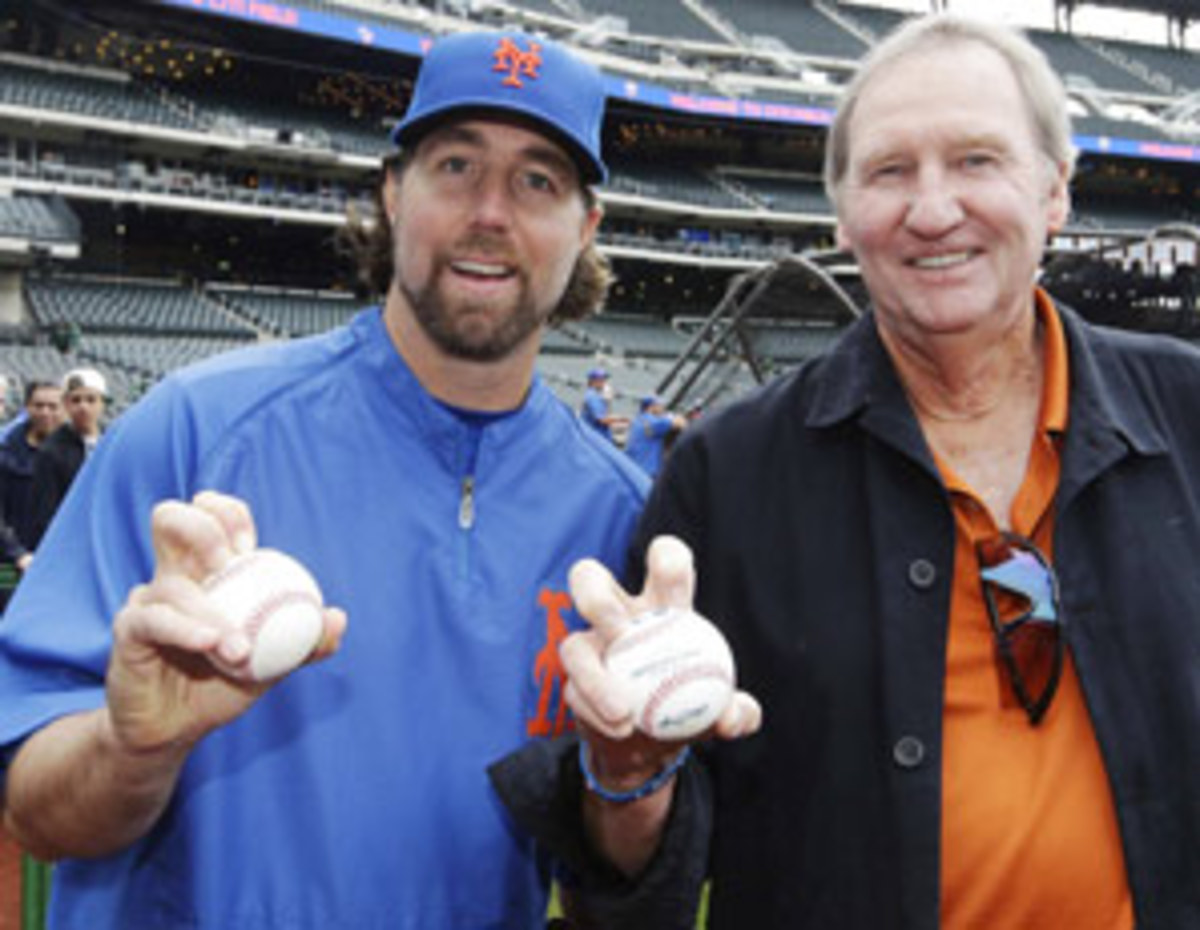
Knuckleball a difficult pitch, but when mastered can save careers
It ducks and dives and tails away. It flutters and then suddenly falls, as if shot from the sky. It's been alternately described as a "whiffle ball in a wind tunnel," a "circus pitch" and a pitch that "changes speed and direction like a drunk driver." "How do you catch a knuckleball?" Bob Uecker was once asked. "Wait until it stops rolling and then pick it up."
The knuckleball is an enduring mystery of baseball, one with no analog in other sports. It's a mystical pitch, a dark art and a lost art, a stiletto at a knife fight. Even its most skilled practitioners struggle to explain its Zen. "It's got a mind of its own," says Tim Wakefield in a new documentary titled, Knuckleball! "It's going to do what it feels like doing and you don't know what that's going to be."
Using his nails and fingertips (not the knuckles), the knuckleballer rears back and doesn't so much throw the ball, as he snaps it. The ball travels at roughly the same pace as interstate traffic, 65-75 mph. Above all, the ball doesn't spin. Maybe a quarter of a rotation, tops. But at some point in its 60.5-foot journey, the seams catch a pocket of air or a wind current and the ball breaks unpredictably.
The results can be comical. The biggest leviathans in the game often take monstrous swings at these slow-moving offerings; and they don't just miss, but miss by entire feet. Batting against the Mets' R.A. Dickey last year, Detroit's Miguel Cabrera swung so ineffectively that he turned to the catcher, Josh Thole, and began laughing. "Can't he throw me a fastball, Papi?"
Yet here's the real mystery: why don't more pitchers try to throw it? Dickey is the only active member of the knuckleball phylum in the majors this season, and you'd think he'd be more of an inspiration. In 2005, Dickey was a struggling pitcher in the Rangers organization when the team asked whether he'd consider trying to become a knuckleballer. He was in his 30s and his Major League record was 15-17. He had given up more hits than innings pitched. He was an easy convert. "I wasn't doing conventional pitching successfully," Dickey says. "For me, it was a pitch born of desperation."
Dickey doesn't knuckle on this topic: the pitch saved his career, a point he makes eloquently in his stellar new memoir, Wherever I Wind Up. For the life of him, he can't figure out why more struggling pitchers don't try to reinvent themselves. "The reward is so much greater than the risk," Dickey says. "You're a quarter of what Phil Niekro was? Well, you're still winning 75 games!"
Framed simply as a financial proposition, there's plenty of incentive to make the switch. The knuckleball pitcher throws at only 70 or 75 percent of his capacity. As a conventional hurler, Dickey would hit his pitch count, begin to fatigue and, invariably, get pulled for a reliever. As a knuckleballer, he asserts he could pitch both games of a doubleheader, no problem. (Mets pitching coach, Dan Warthan, doesn't disagree but says, "I'm not about to test that theory.")
It's not simply that 100 knuckleball pitches don't exact anything close to the physical price as 100 screaming fastballs. Or that a knuckleball outing requires little in the way of recovery. "People forget how much of pitching is warming up and preparation," says Dickey. "Your off-day throwing feels like 70 percent, too."
As a result, knuckleball years become dog years; all the traditional metrics for career longevity flutter like, well, a knuckleball. As Dickey puts it, both of his forefathers, Charlie Hough and Phil Niekro, pitched "with AARP cards in their back pocket." Having won 318 games, Niekro retired at 48, Hough at 46. Wakefield retired before this season, at 45. Dickey will tell you that he's 37 but -- blessed with this mulligan -- feels like he's only starting to enter his professional prime.
In the case of Dickey, just a few years ago he was making $1,800 a month in the minors. This season he'll make $4.5 million for the Mets. Play until your mid-40s, that's a lot of coin. Wakefield never made more than $4,670,000 in a season, but after 19 seasons earned $56 million for his career.
What's keeping the knuckleball industry from thriving? Most obviously, not everyone can master the art of throwing the pitch. Talk to the knuckleballers and, to a man, they point to the world of difference between breaking out the pitch for fun and becoming a full-time devotee. Managers and executives often don't want the hassle and complications that come with such an unconventional pitch. Among catchers, too, it's an acquired taste -- a knuckleball is a passed ball waiting to happen. And pitching coaches can be ambivalent. (When do you take a knuckleballer out of the game? Often it's hard to determine because fatigue is so rarely an issue.)
And, of course, there's still a macho code underscoring much of baseball. It's not every pitcher who can handle the sobering thought of throwing 70-mph offerings to the game's fiercest hitters. "It takes a little nerve," says Hough, "to throw a ball in the big leagues at less than everything you got."
Still, thinking of the wealth of pitchers in the minors, clustered around age 30, their baseball lives headed to the hospice center, wouldn't at least a few of them take a chance on a career-saving pitch? As Wakefield puts it so well in the Knuckleball! documentary, "Let it go and see where it takes you."





